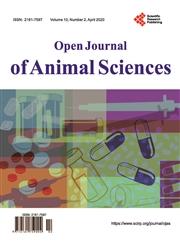Establishing the Tolerability to Turkeys of Nonanoic Acid at Practical Levels of Use as a Feed Flavoring
引用次数: 0
Abstract
Objective: Nonanoic acid (NA) is one of a series of straight-chain aliphatic alcohols, aldehydes, acids and their derivatives with a well-documented history of use as a synthetic flavoring in human food. As part of a safety evaluation of NA for use as a flavoring in animal feed, an experiment was conducted to evaluate the ability of turkeys to tolerate NA at levels relevant to practical feeding practices. Materials and Methods: A total of 594-day-old BUT Premium turkeys (300 males and 294 females) were allocated at random to 40 floor pens containing either 15 males or 13 to 15 females. Poults were fed one of 4 treatment diets in crumble (0 to 14 days) or pellet (15 to 59 days) form containing 0 (control), 100, 300 or 1000 mg NA/kg complete feed for 59 days. General health and performance were monitored for the duration of the study. At days 57 and 59 of age, blood samples were taken and birds were sacrificed and necropsied for histopathological examination of the digestive tract. Significant differences were considered at P ≤ 0.05 and near-significant trends at P ≤ 0.10. Results: NA had no effect on mortality (Pχ2 = 0.54), average daily feed intake (ADFI) (P = 0.11), average daily gain (ADG) (P = 0.12) or feed conversion ratio (FCR) (P = 0.45) in poults over the 56-day feeding period. No treatment-related effects on blood parameters or tissue pathology were observed. Conclusion: The results of the study support the safety and tolerance of NA to turkeys at dietary levels of up to 1000 mg/kg which will provide a considerable margin of safety compared to anticipated practical conditions of use as a feed flavoring.在实际水平上建立Nonanoic酸作为饲料调味品对火鸡的耐受性
目的:壬酸(NA)是一系列直链脂肪醇、醛类、酸类及其衍生物之一,在人类食品中作为合成香料的使用历史已有充分的记载。作为动物饲料中用作调味品的NA安全性评估的一部分,进行了一项实验,以评估火鸡在与实际饲养实践相关的水平上耐受NA的能力。材料和方法:将594天大的BUT优质火鸡(300只雄性和294只雌性)随机分配到40个地面围栏中,围栏内有15只雄性或13至15只雌性。将4种处理日粮中的一种以含有0(对照)、100、300或1000mg NA/kg完全饲料的碎饲料(0至14天)或颗粒饲料(15至59天)形式喂养家禽59天。在研究期间对总体健康状况和表现进行了监测。在第57天和第59天,采集血样,处死鸟类并进行尸检,以进行消化道的组织病理学检查。在P≤0.05时考虑显著差异,在P≤0.10时考虑接近显著趋势。结果:在56天的饲养期内,NA对家禽的死亡率(Pχ2=0.54)、平均日采食量(ADFI)(P=0.11)、平均日增重(ADG)(P=0.12)或饲料转化率(FCR)(P=0.45)没有影响。未观察到对血液参数或组织病理学的治疗相关影响。结论:研究结果支持NA在高达1000mg/kg的饮食水平下对火鸡的安全性和耐受性,与预期的用作饲料调味品的实际条件相比,这将提供相当大的安全性。
本文章由计算机程序翻译,如有差异,请以英文原文为准。
求助全文
约1分钟内获得全文
求助全文

 求助内容:
求助内容: 应助结果提醒方式:
应助结果提醒方式:


